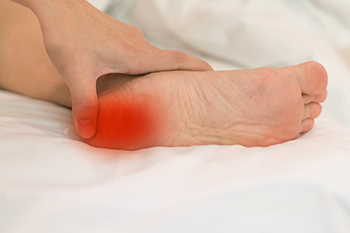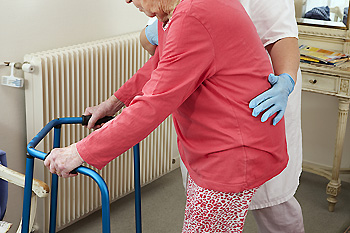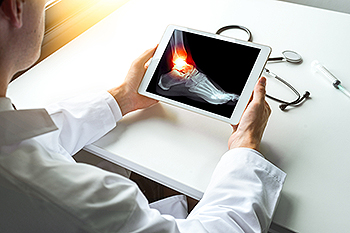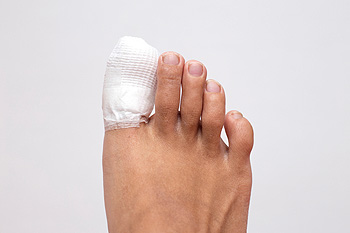Items filtered by date: June 2022
Symptoms and Causes of a Bruised Heel

If you walk or run a lot, you may end up with a bruised heel, an injury that is different from plantar fasciitis. Symptoms of a bruised heel include pain in the bottom of the heel, or the calcaneus, as well as redness or purple bruising on the outside of the heel. A bruised heel can also be caused by sudden trauma to the heel, such as a hard landing from a high jump onto a hard surface. The resulting pain is from an injured fat pad and can take up to three weeks to heal, but if the bone is also injured it may take longer. Additional causes of a bruised heel include wearing flip-flops, landing on your heels when you run, running or walking on hard surfaces, and stepping on a hard stone. Factors that increase risk of heel bruising are obesity, inadequate cushioning in running shoes, overtraining, and running in bare feet. The first thing to do when you have sustained a bruised heel is to cease activity. Consider seeing a podiatrist for information about inserts for your shoes that can provide better cushioning of the heels.
Many people suffer from bouts of heel pain. For more information, contact one of our podiatrists of ABC Podiatry. Our doctors can provide the care you need to keep you pain-free and on your feet.
Causes of Heel Pain
Heel pain is often associated with plantar fasciitis. The plantar fascia is a band of tissues that extends along the bottom of the foot. A rip or tear in this ligament can cause inflammation of the tissue.
Achilles tendonitis is another cause of heel pain. Inflammation of the Achilles tendon will cause pain from fractures and muscle tearing. Lack of flexibility is also another symptom.
Heel spurs are another cause of pain. When the tissues of the plantar fascia undergo a great deal of stress, it can lead to ligament separation from the heel bone, causing heel spurs.
Why Might Heel Pain Occur?
- Wearing ill-fitting shoes
- Wearing non-supportive shoes
- Weight change
- Excessive running
Treatments
Heel pain should be treated as soon as possible for immediate results. Keeping your feet in a stress-free environment will help. If you suffer from Achilles tendonitis or plantar fasciitis, applying ice will reduce the swelling. Stretching before an exercise like running will help the muscles. Using all these tips will help make heel pain a condition of the past.
If you have any questions please contact our office located in Columbus, OH . We offer the newest diagnostic and treatment technologies for all your foot and ankle needs.
Simple Methods That May Help to Prevent Falling

Seniors may be able to remain independent longer when fall prevention techniques are incorporated into their daily routine. These can include performing exercise programs that can help to strengthen the body as well as balancing stretches at home. Additionally, many elderly people make changes to their living environment, including removing frayed rugs and improving lighting in the household. Other effective methods to prevent falling consist of having a grab bar installed in the toilet and shower areas, and it can help to use a non-slip bath mat. It is suggested that physical and eye examinations be performed regularly, and this can help to update existing medication and eyeglass prescriptions. Falling episodes may be lessened when the correct shoes are worn and clutter in the home is cleared. Falling can impact the feet negatively so it is important to learn how to prevent a fall from occurring. If you would like more information about how to prevent falls, please consider speaking with a podiatrist.
Preventing falls among the elderly is very important. If you are older and have fallen or fear that you are prone to falling, consult with one of our podiatrists from ABC Podiatry. Our doctors will assess your condition and provide you with quality advice and care.
Every 11 seconds, an elderly American is being treated in an emergency room for a fall related injury. Falls are the leading cause of head and hip injuries for those 65 and older. Due to decreases in strength, balance, senses, and lack of awareness, elderly persons are very susceptible to falling. Thankfully, there are a number of things older persons can do to prevent falls.
How to Prevent Falls
Some effective methods that older persons can do to prevent falls include:
- Enrolling in strength and balance exercise program to increase balance and strength
- Periodically having your sight and hearing checked
- Discuss any medications you have with a doctor to see if it increases the risk of falling
- Clearing the house of falling hazards and installing devices like grab bars and railings
- Utilizing a walker or cane
- Wearing shoes that provide good support and cushioning
- Talking to family members about falling and increasing awareness
Falling can be a traumatic and embarrassing experience for elderly persons; this can make them less willing to leave the house, and less willing to talk to someone about their fears of falling. Doing such things, however, will increase the likelihood of tripping or losing one’s balance. Knowing the causes of falling and how to prevent them is the best way to mitigate the risk of serious injury.
If you have any questions, please feel free to contact our office located in Columbus, OH . We offer the newest diagnostic and treatment technologies for all your foot care needs.
Gout Pain Can Be Managed
How Long Do I Wear a Boot or Cast for My Broken Foot?

A broken foot can happen for a variety of reasons. These can include falling, dropping a heavy object on it, or possibly from twisting it. An X-ray is typically taken which can determine the severity of the break. This is followed by wearing a cast or boot for approximately six weeks. This is a successful method in stabilizing the foot as the healing process occurs. A broken foot is often accompanied by pain and swelling, and it can help to frequently elevate the foot. After the foot has healed, some patients can benefit from performing specific stretches that may help to improve range of motion. These can consist of pointing and flexing the affected foot, followed by turning the feet in and out. If you have broken your foot, it is strongly suggested that you consult with a podiatrist as quickly as possible who can diagnose and treat it.
A broken foot requires immediate medical attention and treatment. If you need your feet checked, contact one of our podiatrists from ABC Podiatry. Our doctors can provide the care you need to keep you pain-free and on your feet.
Broken Foot Causes, Symptoms, and Treatment
A broken foot is caused by one of the bones in the foot typically breaking when bended, crushed, or stretched beyond its natural capabilities. Usually the location of the fracture indicates how the break occurred, whether it was through an object, fall, or any other type of injury.
Common Symptoms of Broken Feet:
- Bruising
- Pain
- Redness
- Swelling
- Blue in color
- Numbness
- Cold
- Misshapen
- Cuts
- Deformities
Those that suspect they have a broken foot shoot seek urgent medical attention where a medical professional could diagnose the severity.
Treatment for broken bones varies depending on the cause, severity and location. Some will require the use of splints, casts or crutches while others could even involve surgery to repair the broken bones. Personal care includes the use of ice and keeping the foot stabilized and elevated.
If you have any questions please feel free to contact our office located in Columbus, OH . We offer the newest diagnostic and treatment technologies for all your foot and ankle needs.
Buddy Taping May Be a Possible Treatment Method

When patients incur a broken toe, their lives may change temporarily. It may be difficult to walk, and completing daily activities can be challenging. The common symptoms that many people experience with a broken toe can include extreme pain and tenderness, bruising, and swelling. Severe breaks will often display a bone that protrudes through the skin. A broken toe is often the result of a heavy object dropping on it, or being stubbed against a piece of furniture. Relief may come from resting the affected toe, and taping it to the toe next to it. This is referred to as buddy taping, and can be a successful method in providing the stability that is needed as the healing process occurs. Many broken toes are diagnosed by having X-rays taken, and this is helpful in determining the severity of the fracture. A boot or cast may be prescribed for severe breaks, and this can help to alleviate pressure that is put on the toe. If you have broken your toe, it is advised that you seek the counsel of a podiatrist who can help you to treat your it properly.
Broken toes may cause a lot of pain and should be treated as soon as possible. If you have any concerns about your feet, contact one of our podiatrists from ABC Podiatry. Our doctors will treat your foot and ankle needs.
What Is a Broken Toe?
A broken toe occurs when one or more of the toe bones of the foot are broken after an injury. Injuries such as stubbing your toe or dropping a heavy object on it may cause a toe fracture.
Symptoms of a Broken Toe
- Swelling
- Pain (with/without wearing shoes)
- Stiffness
- Nail Injury
Although the injured toe should be monitored daily, it is especially important to have a podiatrist look at your toe if you have severe symptoms. Some of these symptoms include worsening or new pain that is not relieved with medication, sores, redness, or open wounds near the toe.
If you have any questions, please feel free to contact our office located in Columbus, OH . We offer the newest diagnostic and treatment technologies for all your foot care needs.





